It was in the ancient Near East, the so-called Cradle of Civilization, that the birth of art took place. Centuries before the easily recognizable Greek and Roman artistic traditions flourished, the civilizations of the Near East, which stretched from the Levant through Anatolia, Mesopotamia, Elam, and central Asia, were producing complex and varied works. The archaeology of this region is unique, due to the fact that many of these ancient cultures settled in oases--isolated areas that provided the necessities of life in the midst of the harsh desert climate. Such sites were occupied for thousands of years and often by more than one cultural group.
Thus, this vast geographical area boasts a diverse array of styles which are affected by the idiosyncrasies of the specific region and people and differ from period to period. Although a single stylistic unity is not evident, the cross-cultural exchange of ideas, materials, and forms is easily discernible.
Sculpture
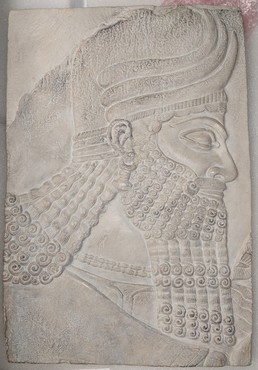
Head of a Genius
Near Eastern (Assyrian)
replica: from the Gipsoformerei, Berlin
medium: plaster; alabaster original
gift of: the Nasser Family
date of the original: c. 883 - 859 BCE
provenance of the original: Palace of Kalhu, Kalhu (modern Nimrud), Iraq; now in the Pergamonmuseum, Berlin
description: This relief of a genius, or protector demi-god, originates from the reign of Ashurnasirpal II, an Assyrian king whose success came from his numerous campaigns, his military leadership, and diplomacy. This specific relief was found in the king’s palace in Kalhu, and was one of many such reliefs that decorated the palace walls. Genii were anthropomorphic supernatural beings, but they also could be represented as animal hybrids with the heads of eagles. They often had wings and were considered protective deities, particularly with respect to royalty, which explains their frequent depiction in palaces.

Presumed Head of Hammurabi
Near Eastern (Babylonian)
replica: from the Louvre, Paris
gift of: the Nasser Family
medium: plaster; diorite original
date of the original: early 2nd millennium BCE
provenance of the original: Susa (modern Shush), Iran;
now in the Louvre, Paris
description: This presumed portrait head of the Babylonian king Hammurabi (1792-1750 BCE) was once part of a full-length statue. the type of headdress and the artistic style in which the hair and beard are carved allows art historians to date this statue to the era of Hammurabi or just prior. Despite the naturalistic expression and aged facial features, it is difficult to pinpoint the identity of the figure. Hammurabi’s fame is due in large part to his detailed law code, which predates Biblical law, and he is recognized for ushering in the beginning of Babylon’s political rule over southern Mesopotamia.

Woman Holding An Aryballos
Near Eastern (Sumerian)
replica: from Louvre, Paris
gift: of the Nasser Family
medium: plaster; alabaster original
date of the original: 2114 - 2004 BCE provenance of the original Girsu (modern Tello), Iraq; now in the Louvre, Paris
This beautiful statuette was created during the Third Dynasty of Ur, which was known as the ‘Sumerian Renaissance’, a period in which Sumerian art and literature began to flourish. This portrait exemplifies a desire by artists to depict the subject in a more realistic way. She is seated with her feet close together while holding an object, here a perfume vessel called an aryballos, which was perhaps used in ritual offerings and prayers to the gods.
Although the woman presented in this portrait is of high status, it is not clear who this woman is. She could be princess Enanatuma, who was also a priestess and representative of the goddess Ningal during ritual activity. Ningal was the wife of the moon god Nanna and the mother of the sun god Utu.
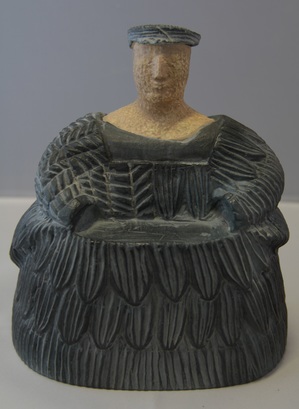
A ‘Princess’ of Bactria
Near Eastern (Bactrian)
replica: from Louvre, Paris
gift: of the Nasser Family
medium: plaster; calcite and steatite original
date of the original: late 3rd to early 2nd millennium BCE provenance of the original Bactria-Margiana Complex, Afganistan; now in the Louvre, Paris
Bactria was located in modern day Afghanistan and was a wealthy state due to their exchange of raw materials with Mesopotamia. This elegant statuette of a women in an elaborate dress was one some forty such figures found throughout Bactria and are commonly referred to as “Bac- trian princesses.”
While most “Bactrian princesses” are depicted seated, this one is shown standing and is a slightly larger size than the others. Her dress is quite striking and full, sculpted from green- ish-grey steatite and represents a kaunakes, a Sumerian style of skirt made of tufts of wool, here having the appearance of leaves. It has been speculated that these objects represent a female divinity, although no definitive proof has been found to support this claim.
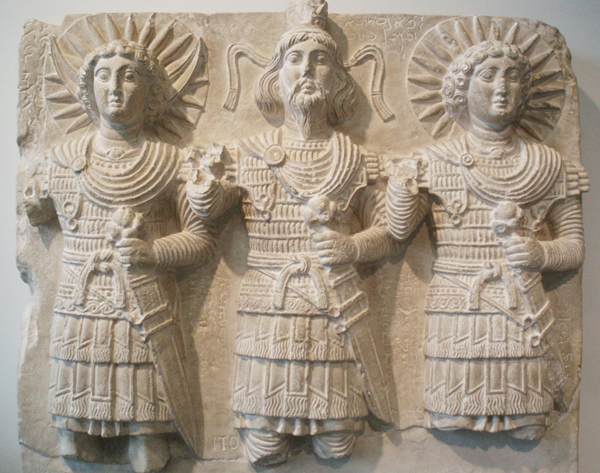
Semitic Gods
Near Eastern (Palmyrene)
replica: from the Louvre, Paris
date of the original: 1st or 2nd century AD
provenance of the original: Court of the Temple of Bel, Palmyra, Syria; now in the Louvre, Paris
description: Relief of three standing gods, facing front, all in military garb. Plaster replica; limestone original. Height 61 cm, width 73 cm, depth 16 cm.
This triad of Baalshamin (center) and Malakbel and Aglibol (gods of the sun and moon) comes from the temple of Bel in Palmyra in the Syrian desert on an important caravan route to Babylonia. It is probably the work of a Greek artist, on the outskirts of the Roman Empire in the first or second century AD. The view that it is of an even later date could find its defenders.
The frontality and resulting hieratic attitude reinforced by the identical posture of all three is perhaps an eastern artistic habit in representing figures, but a western approach is evident in details. The spread of western influence to Palmyra is evident from the Hellenistic lamellar armor worn by the gods and the Roman gladius (sword) carried by all three. Underneath are worn traditional eastern tunics and trousers.
(See also: Relief of Aththaia; Relief of Maliku.)

Panel from the Frieze of Archers
Near Eastern (Achaemenid Persian)
replica: from the Louvre, Paris
gift of: the Nasser Family
date of the original: c. 510 BC
provenance of the original: Tell of the Apadana, Palace of Darius I, Susa, Iran; now in the Louvre, Paris
description: Depicts a standing archer. Resin panel; replica of part of the original frieze of polychrome glazed siliceous brick. Height 100 cm, width 35 cm, depth 6 cm.
One panel from a frieze at the Palace of Darius the Great (548-486 BC). The frieze displays two symmetrical lines of soldier-archers.
Each archer holds a spear with both hands, with his bow and quiver over his shoulder. The archers are bearded and wear laced ankle boots, long Persian robes, and diadems.
The frieze was inspired by the Processional Way in Babylon, constructed by Nebuchadnezar II (604-562 BC). However, the technique involved is different. The Babylonians used clay for their bricks, but this Persian frieze has bricks of a siliceous clay. They are decorated in low relief and with glazes of green, brown, blue, white and yellow.
The original location of the frieze of archers in the Palace of Darius is unknown, as the bricks and fragments were found scattered throughout the palace.
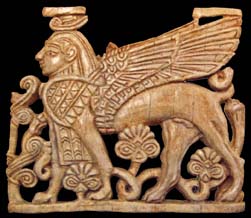
Ivory Winged Sphinx
Near Eastern (Phoenician)
replica: by artist Carrie Allen
gift of: the Nasser Family
date of the original: 9th-8th century BC
provenance of the original: Fort Shalmaneser, Kalhu (Nimrud), Iraq; now in the British Museum, London
description: Ornamental sphinx. Plaster reproduction; ivory original. Height 5 cm, width 7 cm.
The ancient Phoenicians were renowned artisans and expert ivory carvers. Stylistically, Phoenician wares do not follow a strict artistic tradition, but show the influence of neighbouring cultures’ styles.
Egyptian influence can be clearly seen in this replica carving, which features a winged sphinx (see: Sphinx) adorned with the crown of Upper and Lower Egypt.
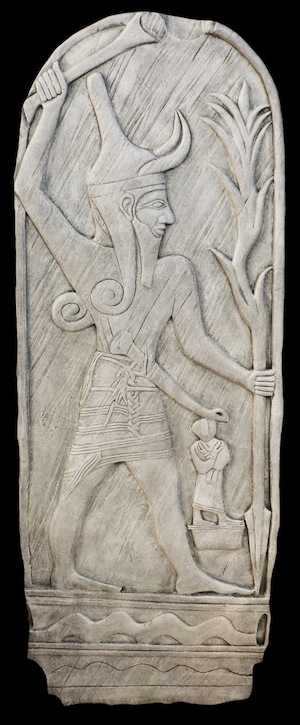
Baal
Near Eastern (Canaanite/Semitic)
replica: by artist Carrie Allen
gift of: the Nasser Family
date of the original: 18th-15th century BC
provenance of the original: western wing of the Temple of Baal, Acropolis, Ugarit (Ras Shamra); now in the Louvre, Paris
description: The god Baal standing with a club in his raised right hand and a lightning bolt/spear in his left; a smaller figure stands under Baal’s dagger. Plaster replica; limestone original. Height 151 cm, width 51 cm, depth 4 cm.
Baal was a Canaanite fertility deity who later emerged as a rain god. Thus he became known as a rider of clouds, most active during storms.
Although the most vigorous and aggressive of the gods, he was the one on whom mortals depended most. Baal’s disappearance into the netherworld with the rainclouds was believed to bring about the dry summer. The cult of Baal celebrated his death and resurrection annually.
The eclectic artistic style represented by this panel grew out of a maritime livelihood. The Canaanites developed permanent cities along the coast of modern-day Lebanon. The items they produced were for Mediterranean and Near Eastern clients. By creating art that had an unusual combination of decoration, they achieved stylistically attractive and symbolically recognizable goods. Egyptian influence is apparent in this carving of Baal in his “smiting” pose.
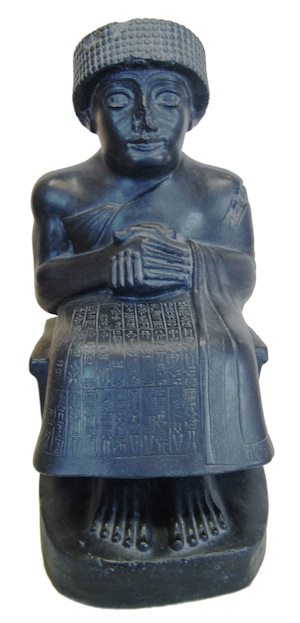
Gudea of Lagash
Near Eastern (Neo-Sumerian)
replica: from the Louvre, Paris
gift of: the Nasser Family
date of the original: 2120 BC
provenance of the original: "Tablet Mound," Tello (ancient Girsu), Iraq; now in the Louvre, Paris
description: Gudea seated, wearing turban with stylized curls, with hands joined. Plaster replica; diorite original. Height 47 cm, width 23 cm, depth 32 cm.
Gudea was ensi (governor) of the Sumerian city-state of Lagash from 2144 to 2124 BC. He also wielded a consierable amount of influence in other parts of Mesopotamia. In the foundations of a temple to Ningirsu (a war god) he buried a number of clay tablets with cuneiform (see:Black Obelisk) inscriptions. These tablets give accounts of his activities at the temple which communicate his feelings, moods, and dreams.
The original of this statue of Gudea is made of diorite, imported from Egypt. All but one of the twenty extant statues of Gudea were crafted from this stone. His clean-shaven face is calm and smiling; large, fishbone-like eyebrows arch above his almond-shaped eyes. Here he is depicted wearing the royal turban and an Akkadian draped/fringed robe which leaves one muscular arm uncovered. His joined hands are a symbol of piety.
The statue’s proportions are unusual: the absence of a neck makes the head seem too large for a body that looks too small. However, the undeniable quality of the workmanship rules out clumsiness on the part of the sculptor. The figure’s odd proportions are probably a stylistic convention of the period.
Pottery
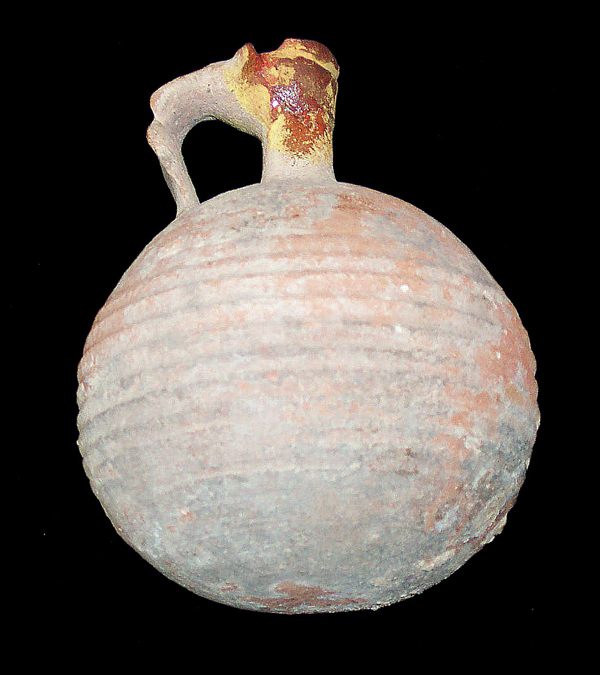
Herodian Juglet
Near Eastern
original
gift of: Lois Dumbovic
date: c. first century AD
provenance: Jerusalem
description: A wheel-made terracotta juglet with a globular body, small neck and rim (damaged), and flat handle. The body bears a grooved pattern. It is a table juglet, used for storing, preparing and serving liquids. Height 11 cm, diameter 9 cm.
(See also: Black Pottery Juglet; Small Black Juglet; Hellenistic Juglet.)
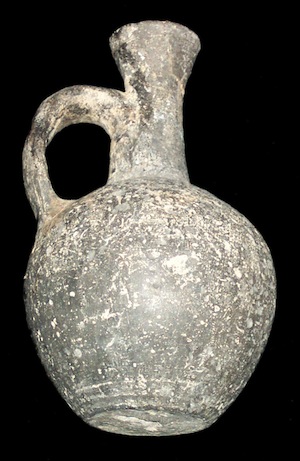
Black Pottery Juglet
Near Eastern (Late Bronze Age)
original
gift of: Lois Dumbovic
date: c. 1500-1200 BC
provenance: Jericho
description: This black clay, one-handle juglet is a wheel-made table vessel. Height 14 cm, diameter 8 cm.
(See also: Herodian Juglet; Small Black Juglet; Hellenistic Juglet.)
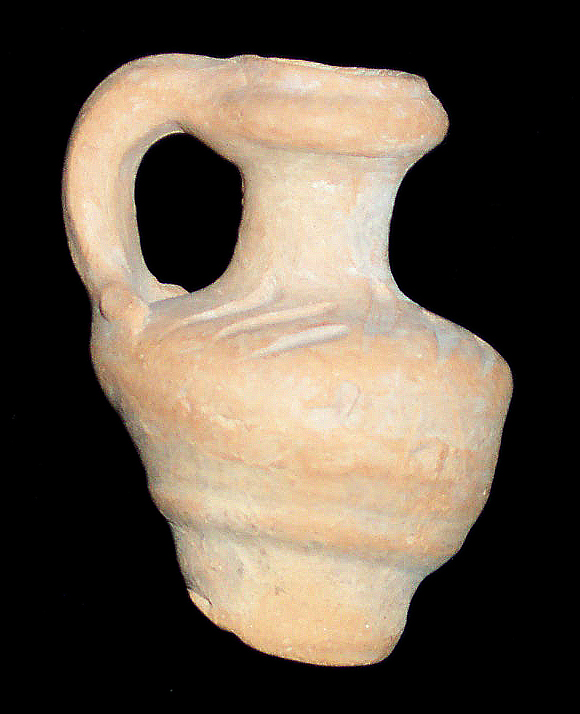
Hellenistic Juglet
Near Eastern
original
gift of: Lois Dumbovic
date: c. 200 BC (Hellenistic Period)
provenance: Jerusalem
description: A small terracotta juglet, roughly made with an uneven base. There are groups of three incised lines in alternating directions on its body. It was probably a dipper juglet. Height 7 cm, diameter 4.5 cm.
(See also: Herodian Juglet; Black Pottery Juglet; Small Black Juglet.)

Piriform Jug
Syro-Palestinian
original
gift of: the Minden Family
date: c. 20th - 18th century BC
provenance: Syro-Palestine
description: Jug with a piriform body, cylindrical neck and double loop handle.
Terracotta.
Height: 16.7 cm
Diameter: 10 cm
Intact, overall wear and encrustation.

Small Black Juglet
Near Eastern (Iron Age)
original
gift of: Lois Dumbovic
date: c. 1000-900 BC
provenance: Hebron
description: This small, black-slipped juglet is roughly made with an uneven cone-shaped base. It was probably a dipper juglet, used for pouring out small amounts of precious liquids like perfume or oil. Dipper juglets containing olive oil were commonly used to fill oil lamps. Height 6 cm, diameter 6 cm.
(See also: Herodian Juglet; Black Pottery Juglet; Hellenistic Juglet.)

Tapered Juglet
Syro-Palestinian
original
gift of: the Minden Family
date: c. 1st - 2nd century AD
provenance: Syro-Palestine
description: Juglet with a tapered body, loop handle.
Terracotta.
Height: 21 cm
Diameter: 7.1 cm
Intact, minor encrustation.
Oil Lamps
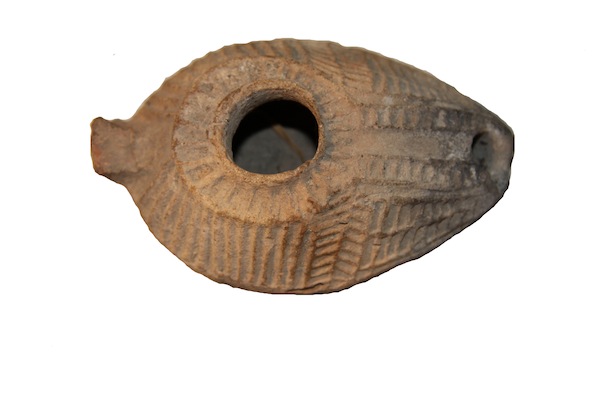
Geometric Oil Lamp
original
gift of: the Minden Family
date: c. 6th century AD
provenance: Israel
description: Lamp decorated with linear geometric panels.
Terracotta.
Width: 6 cm
Height: 9.6 cm
Intact, encrustion, label bearing "17" to the base.
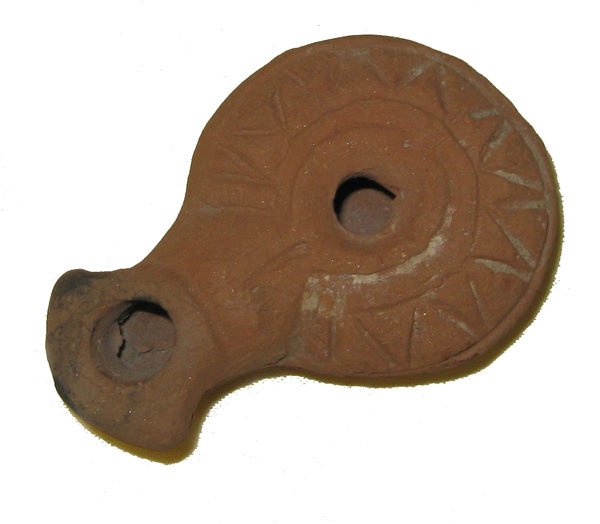
Hellenistic Oil Lamp
Near Eastern
original
gift of: Lois Dumbovic
date: c. 200 BC
provenance: Jerusalem
description: A small terracotta lamp with a geometric pattern on the shoulder. Soot marks. Mould-made. Length 7 cm.
(See also: Herodian Oil Lamp; Jewish/Samaritan Oil Lamp.)
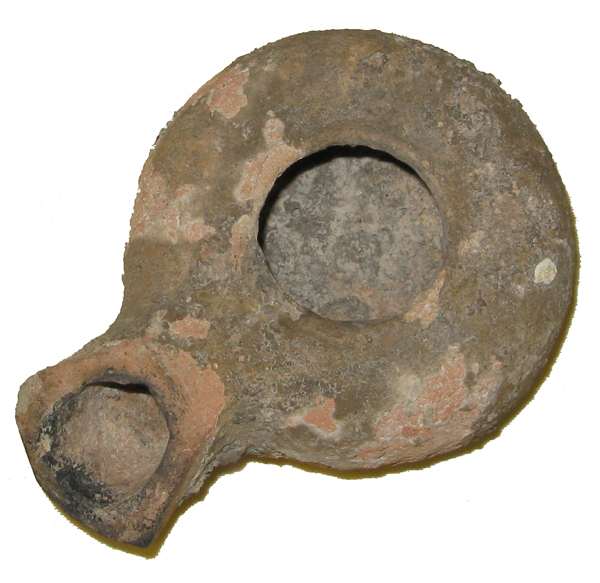
Herodian Oil Lamp
Near Eastern
original
gift of: Lois Dumbovic
date: c. 37 BC - 100 AD
provenance: Jerusalem
description: This undecorated terracotta lamp has a round, wheel-
made body, termed a “knife-pared” lamp, typical of its period. It is heavily encrusted with dirt and soot. Length 8 cm.
(See also: Hellenistic Oil Lamp; Jewish/Samaritan Oil Lamp.)
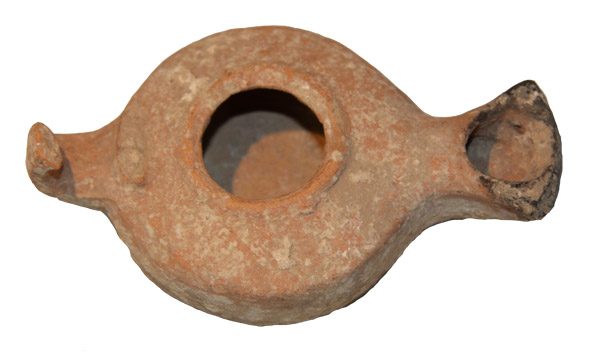
Herodian Oil Lamp
original
gift of: the Minden Family
date: c. 1st c. AD
provenance: Israel.
description: Lamp of Herodian form.
Terracotta.
Height: 9 cm
Width: 5.4 cm
Handle broken, encrustation, label bearing "15" to the base.
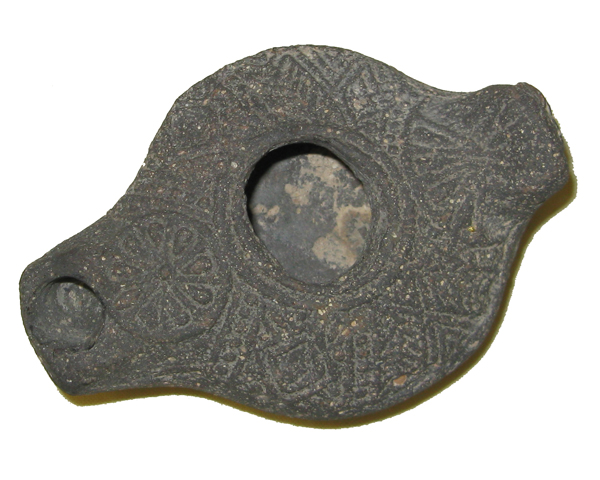
Jewish/Samaritan Oil Lamp
Near Eastern
original
gift of: Lois Dumbovic
date: 300-500 AD
provenance: Jerusalem
description: Black clay lamp with a complex geometric and rosette design on the shoulder and a fan-shaped handle. Mould-made. Length 9.25 cm.
(See also: Herodian Oil Lamp; Hellenistic Oil Lamp.)

Pinched Oil Lamp
Syro-Palestinian
original
gift of: the Minden Family
date: c. 8th century BC
provenance: Syro-Palestine
description: Lamp of saucer form with a pinched nozzle.
Terracotta.
Height: 5 cm
Width: 14.2 cm
Intact, encrustation.
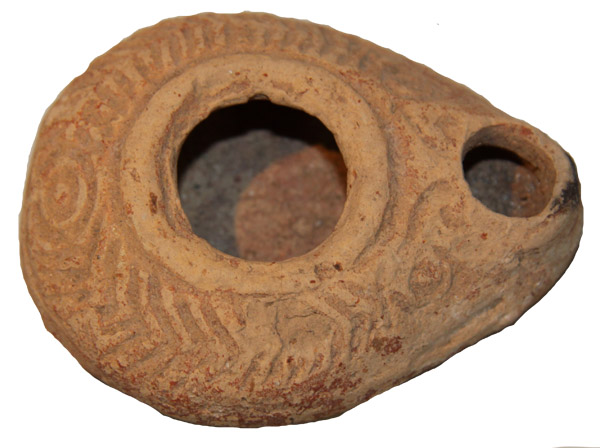
"Wreath" Oil Lamp
original
gift of: the Minden Family
date: c. 4th century AD
provenance: Israel.
description: Lamp decorated with a wreath.
Terracotta, red slip.
Height: 7.5 cm
Width: 5.8 cm
Intact, wear, encrustation, label bearing "16" to the base.
Figurines & Amulets

"Hell" Plaque
Near Eastern (Neo-Assyrian)
replica: from the Louvre, Paris
gift of: the Nasser Family
date of the original: 934-612 BC
provenance of the original: Mesopotamia or Syria; now in the Louvre, Paris
description: Relief scenes on plaque with figurine peering over the top. Resin replica; bronze original. On base: height 15.5 cm, width 10 cm, depth 4 cm.
The so-called “Hell Plaque” is an Assyrian healing device against the demoness Lamashtu. Often called “she who erases,” Lamashtu was blamed for the deaths of children and mothers, poisoning water, killing plants, and causing nightmares. She was also believed to consume the flesh and drink the blood of adult men. She had a hairy body with the head of a lioness, the teeth and ears of a donkey, and bird talons.
This plaque was hung over the bed of an invalid in hopes of driving Lamashtu out. She herself is depicted in the lower register, holding snakes and suckling lion cubs while riding a donkey in a boat. The uppermost register displays the different gods involved in the healing process: the sun of Shamash, the crescent moon of Sin, the lightning bolt of Adad, and the winged disc of Ashur. In the second register, seven animal-headed spirits guard the door to a bedchamber. In the third register, the patient is depicted lying on a bed, flanked by two priests, who are aided by three animal spirits. Overlooking the plaque is Lamashtu’s husband, the demon Pazuzu (see: The Demon Pazuzu), the only one who is able to coax her away.
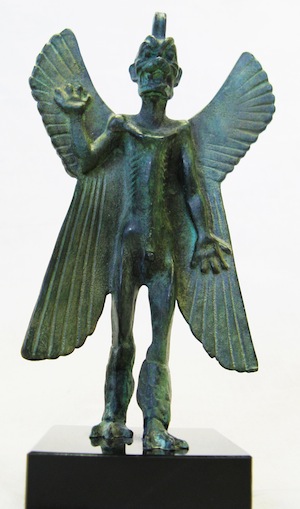
The Demon Pazuzu
Near Eastern (Assyrian)
replica: from the Louvre, Paris
gift of: the Nasser Family
date of the original: late 7th-8th century BC
provenance of the original: Mesopotamia; now in the Louvre, Paris
description: Demon with a double set of wings, head of a dragon/snake, body of a man with one upraised arm, scorpion’s tail and talons. Resin replica; bronze original. Height 18 cm, width 9 cm, depth 5 cm.
The demon Pazuzu was the Assyrian king of the demons of the wind. He was associated in particular with the southwest wind that brought droughts, famine and locusts. Although a demon, Pazuzu was a source of protection against the demoness Lamashtu (often depicted as his wife): he could drive her back to the underworld (see: "Hell" Plaque). Because Pazuzu could protect against Lamashtu, his image was often used on protective amulets or plaques. Pazuzu was depicted as a man with the head of a lion or dog, talons instead of feet, two pairs of wings, and the tail of a scorpion. His right hand is raised and his left hand is extended downwards: this position represents life/death and creation/destruction.
The original statuette has an inscription on the back (not present in this replica) stating “I am Pazuzu, son of Hanpa, king of the evil spirits of the air which issues violently from the mountains, causing much havoc.” The ring atop his head suggests that the piece was intended to be hung, perhaps in the room of an invalid.

Goddess or Adorant
Syro-Palestinian
original
gift of: the Minden Family
date: c. 2000 BC
provenance: Syro-Palestine
description: Figurine representing either a goddess or an adorant.
Height: 12 cm
Diameter: 4.5 cm
Pastiche rejoined from fragments, minor encrustation.

Two Bronze Deities
Near Eastern (Syrian/Canaanite)
replica: from the Louvre, Paris
gift of: the Nasser Family
date of the original: 1500-1000 BC
provenance of the original: Syria
description: Two figures (one male, one female) attached at the hip. Bronze replica; bronze original. Height 13.5 cm, width 5 cm, depth 4 cm.
This Canaanite figurine is characteristic of divinity statues from Syria. The figures are very flat in shape, with large bald round heads, large narrow noses, long slender necks and inset eyes.
It is generally agreed that these images depict male and female deities. Most of these figures have been found in sanctuaries and in high or remote places, and thus seem to hold some ritual significance. They may have functioned as votive statues (see: Cycladic Idol;Kouros of Paros) or amulets (see: Faience Amulets; Bronze Amulets).
This figurine was cast in bronze using the lost-wax method. Other similar pieces were made from silver and gold, created by hammering the metal over a bronze core. These figurines may have had wooden precursors which are not preserved in the archaeological record.
Inscriptions
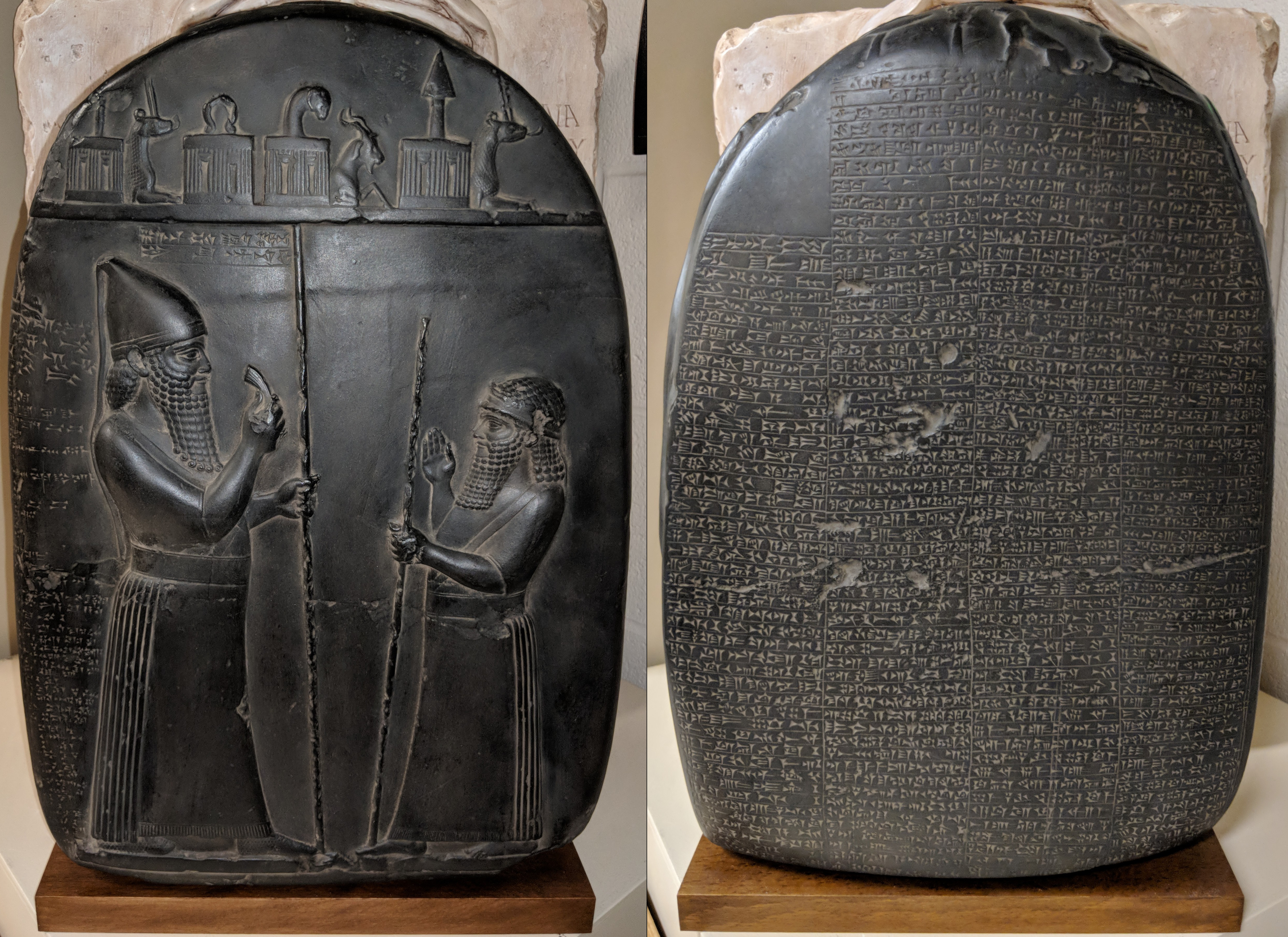
Boundary Stone With Inculcation Ceremony
Near Eastern (Babylonian)
replica: from Gipsoformerei, Berlin
gift: of the Nasser Family
medium: plaster; limestone original
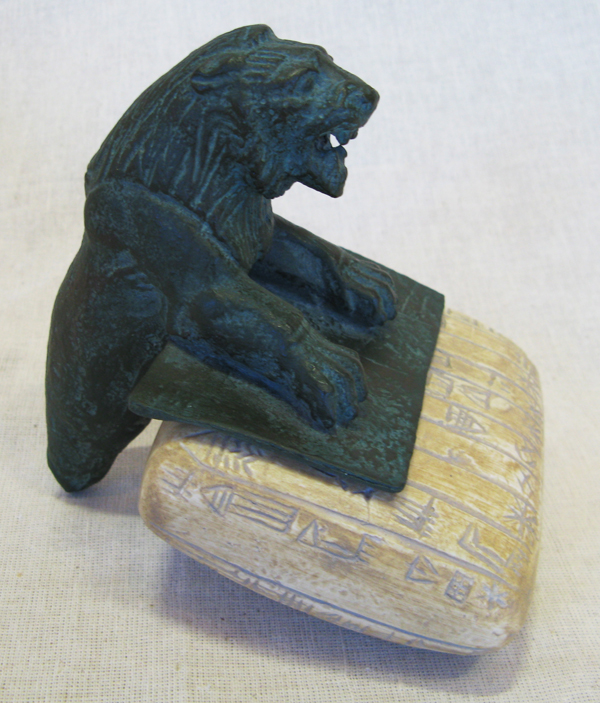
Urkesh Lion
Near Eastern (Akkadian)
replica: from the Louvre, Paris
gift of: the Nasser Family
date of the original: 21st century BC (Empire of Ur III)
provenance of the original: Tell Mozan (Northeastern Syria); now in the Louvre, Paris
description: Lion perched on tablet. Resin replica; copper and limestone original. Lion: height 12 cm, width 8.5 cm, depth 3 cm. Tablet: height 10 cm, width 8 cm, depth 3 cm.
Foundation pegs, like this replica of the Urkesh Lion from the temple of Nergal (god of the underworld), were planted in temple foundations for protection. They served as offerings and were inscribed with cuneiform curses (the text on the Urkesh Lion’s tablet is the oldest inscription in the Hurrian language) which warded the temple from harm and desecration.
An approximate translation of the curse:
“Tishatal, [Endan] king of Urkesh, has built a temple for the god Nergal. May the god Nubadag protect this temple. May Nubadag destroy whomsoever seeks to destroy [it]; may his god not listen to his prayers. May the Lady of Nagar, [the sun god] Shimiga, and the god of the storm [curse 10,000 times whomsoever might seek to destroy it].”

Panel from the Black Obelisk of Shalmaneser III
Near Eastern (Assyrian)
replica: from the British Museum, London
gift of: Dr. Gary Hanson, for Dr. Michael Swan, for excellence in graduate teaching supervision
date of the original: c. 825 BC
provenance of the original: Kalhu (Nimrud), Iraq (discovered by Sir Austen Henry Layard in 1846); now in the British Museum, London
description: This is one side of the original obelisk, which stands two metres tall and has four sides, each with 5 picture panels interspersed with cuneiform inscriptions. There is also cuneiform above and below each set of pictures. The inscriptions record the annals of thirty-two years of the reign of the Assyrian king Shalmaneser III (r. 858-824 BC). Most of the illustrations record the tributes brought to Shalmaneser by various vassal kings. This panel: plaster replica; black alabaster original. Height 112 cm, width 55.5 cm, depth 5.5 cm.
The Black Obelisk became famous when scholars realized that it made reference to Jehu, King of the Israelites. who is mentioned in the Old Testament (Kings 19.16; 2 Kings 9-10). A descendant of Shalmaneser III, Shalmaneser V, is mentioned in 2 Kings 17:3 and 18:9. The Black Obelisk also mentions the King Hazael of Damascus who appears in the Old Testament (2 Kings 8:28f; 9:14f).
The top panel of the replica shows Sua, the Gilzanite, bringing tribute to Shalmaneser, who is standing to the left, armed with a bow and arrows and accompanied by an attendant and soldier. Above this scene are the winged sun-disc, divine symbol of the god Assur, king of all of the great gods, and the eight-pointed star, divine symbol of Enlil, creator and father of the gods.
The second panel, which is possibly the most significant, depicts Shalmaneser receiving tribute from Jehu, king of Israel, who is prostrate before the king. Shalmaneser holds a bowl in his raised hand and is sheltered by a parasol held by an attendant.
The tribute of the country of Musri, illustrated on the third panel, consists entirely of animals led or driven by attendants dressed in knee-length garments.
The fourth panel illustrates two lions hunting a stag in a forest, perhaps reminiscent of the countries which Shalmaneser has conquered.
The bottom panel records the tribute of Karparunda of Hattina, brought forth by porters wearing pointed caps.
Translations of the inscriptions describing each scene:
I. Tribute of Sua, the Gilzanite. Silver, gold, lead, copper vessels, staves (staffs) for the hand of the king, horses, camels, whose backs are doubled, I received from him.
II. Tribute of Jehu, son of Omri. Silver, gold, a golden saplu (bowl), a golden vase with pointed bottom, golden goblets, pitchers of gold, tin, staves (staffs) for the hand of the king, puruhtu (javelins?), I received from him.
III. Tribute of the land of Musri. Camels whose backs are doubled, a river ox (hippopotamus), a sakea (rhinoceros), a susu (antelope), elephants, bazîtu (and) uqupu (monkeys), I received from him.
IV. Tribute of Marduk-apal-usur of Suhi. Silver, gold, pitchers of gold, ivory, javelins, buia, brightly colored and linen garments, I received from him.
V. Tribute of Karparunda of Hattina. Silver, gold, lead, copper, copper vessels, ivory, cypress (timbers), I received from him.
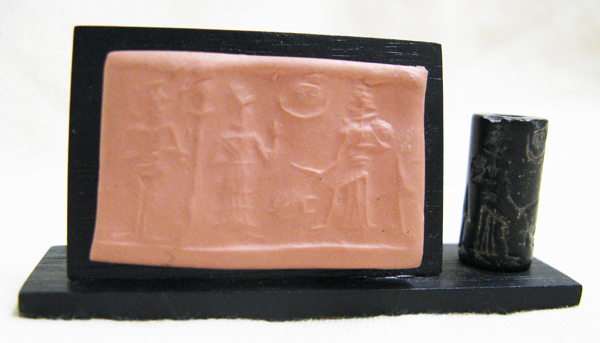
Cylinder Seal
Near Eastern (Babylonian)
original
gift of: Professor Thurston Lacalli
date: 4th to 2nd millennium BC
provenance: purchased by donor
description: An original black stone cylinder seal, with hole through centre. Engraved with symbols and figures depicting a presentation scene. A moulded impression of the seal is mounted beside. Length 2 cm, diameter 1 cm.
Cylinder seals were rolled over wet clay, leaving an engraving on tablets, bricks or ceramics. The use of these seals coincides with the use of clay tablets in the Near East which began at the end of the fourth millennium BC.
This seal is probably Babylonian; possibly Sumerian.
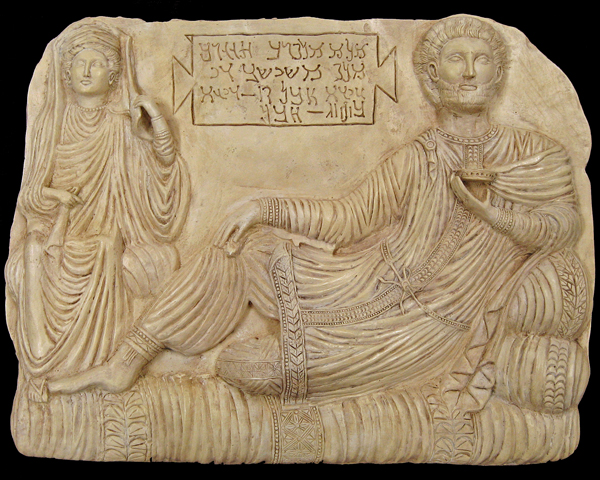
Relief of Maliku
Near Eastern (Palmyrene)
replica: by artist Carrie Allen
gift of: the Nasser Family
date of the original: 200-250 AD (Roman Period)
provenance of the original: Palmyra (Tudmur), Syria; now in the Louvre, Paris
description: Reclining man holding a small vessel; his wife sits to the side. Inscription at top. Plaster replica; limestone original. Height 52 cm, width 45 cm, depth 4 cm.
This funerary stele depicts a man named Maliku, accompanied by his wife, Hadira, attending a banquet. It was custom in the Greco-Roman world to recline at banquets, and in Palmyra it became common to represent the practice on funerary steles. The faces of the deceased were always shown straight-on to the viewer, the eyes enlarged with incised pupils, sometimes highlighted with color.
Maliku is clothed in the Parthian tradition of caravan traders, with an embroidered tunic, embroidered baggy trousers, and a cloak held with a fibula at the shoulder. Hadira is adorned with jewelry reflecting the prosperity of her husband. Although she occupies an honoured position beside Maliku, even reaching the same height as her reclining husband, her lower status is indicated by the fact that she is seated at his feet. The inscription is in Palmyrene (an Aramaic dialect) and reads “Image of Maliku, son of Hagegu, son of Maliku, priest of the temple precinct, alas! and Hadira his wife.”
(See also: Relief of Aththaia; Semitic Gods.)
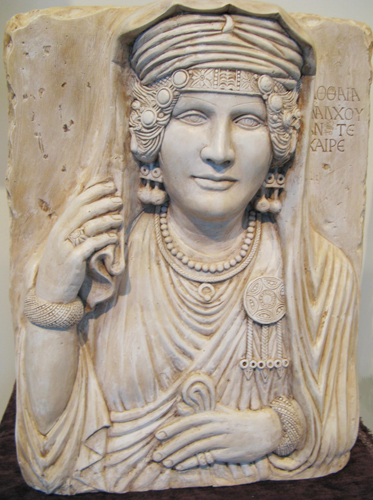
Relief of Aththaia
Near Eastern (Palmyrene)
replica: by artist Carrie Allen
gift of: the Nasser Family
date of the original: 150-200 AD (Roman Period)
provenance of the original: Palmyra (Tudmur), Syria; now in the Museum of Fine Arts, Boston
description: Relief bust of a woman adorned with jewelry, touching her draperies with one hand. Inscription at right side. Plaster replica; limestone original. Height 53 cm, width 43 cm, depth 15 cm.
This funerary stele depicts a woman named Aththaia, dressed in a full tunic and long himation which covers her head. Beneath this she wears a headdress and diadem with a string of jewels. She has elaborate earrings, two necklaces, three bracelets, three rings, and a brooch with three pendants. Her attire shows strong eastern influences.
The inscription, in Greek, reads “Aththaia, daughter of Malchos, dear one, farewell.”
(See also: Relief of Maliku; Semitic Gods.)
Metal Crafting & Jewelry

Gilded Silver Vessel
Near Eastern (Late Sasanian/Early Islamic)
replica: from Gipsformerei, Berlin
gift: of the Nasser Family
medium: resin; gilded silver original
date of the original: 601 - 800 CE provenance of the original found in Russia, likely produced elsewhere; now in the Pergamonmuseum,
This vessel has a small puncture near the base used to strain haoma, the sacred vine important in Zoroastrian religion. The source of haoma is the Iranian Tree of Life, identifiable by the attached vines. Sprigs of the haoma were brought to earth by divine birds, represented here as large cranes. The left-facing crane seems to be characteristic of early Islamic work, as right-facing images were typical of the Sasanian period.
The Tree of Life was planted alongside another tree called the Impassive, represented on the opposite side of the vessel. The Impassive tree bore fruit containing the seeds of every kind of plant including the extending typha reeds (cattail). The lower vines encircle two small birds, ready to carry the fallen seeds to the rain god Tištrya to purify the lands and bestow fertility.
The iconographic result of the vessel depicts natural harmony and the existence of freedom in nature.
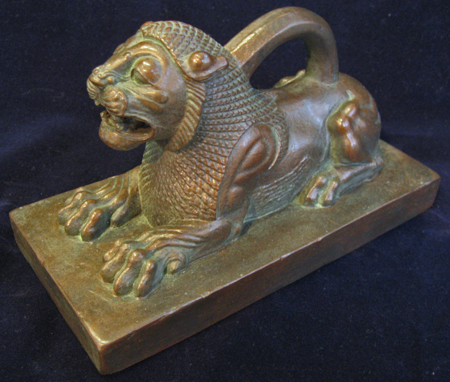
Bronze Lion Weight
Near Eastern (Persian)
replica: from the Louvre, Paris
gift of: the Nasser Family
date of the original: 648-330 BC
provenance of the original: Susa, Iran
description: Weight in the shape of a lion with a handle on its back. Resin reduced-scale replica; bronze original. Height 11 cm, width 18.5 cm, depth 8.5 cm.
Prior to the invention of coinage (see: Original Coinage), commerce involved the exchange of materials like metal scraps or ingots. Over time, several cultures of the ancient Near East began to utilize standardized metal weights.
The Assyrians made their weights in the form of reclining lions to symbolize strength and power. The Persians later imitated the Assyrian lion weights. This reduced model is from an original made on the occasion of the festival of Persepolis, to be offered as a gift to notable persons. (The original weighs 121 kg.)

Four Necklaces
Syro-Palestinian
originals
gift of: the Minden Family
provenance: Syro-Palestine
1) date: c. 2nd - 1st millennium BC
description: Faience, "Egyptian blue" frit and glass.
Length: 40 cm
2) date: c. 1st millennium BC
description: Stone, carnelian and modern metal spacer beads.
Length: 47 cm
3) date: c. 1st millennium BC
description: Shell, stone, "Egyptian blue" frit and glass.
Length: 49 cm
4) date: c. 2nd - 1st millennium BC
description: Copper, stone, faience and shell.
Length: 50 cm

Six Necklaces
Syro-Palestinian
originals
gift of: the Minden Family
provenance: Syro-Palestine
1) date: c. 1st - 4th centuries AD
description: Swirl-pattern glass.
Length: 36 cm
description: Glass, carnelian and modern spacer beads.
Length: 42 cm
3) date: c. 1st - 4th centureis AD
description: Swirl-pattern glass and modern spacer beads.
Length: 40 cm
4) date: c. 1st - 4th centuries AD
description: Glass and modern metal spacer beads.
Length: 40 cm
description: Glass, two modern Venetian trade beads and modern metal
spacer beads.
Length: 40 cm
6) date: c. 1st - 4th centuries AD
description: Glass and modern spacer beads.
Length: 42 cm